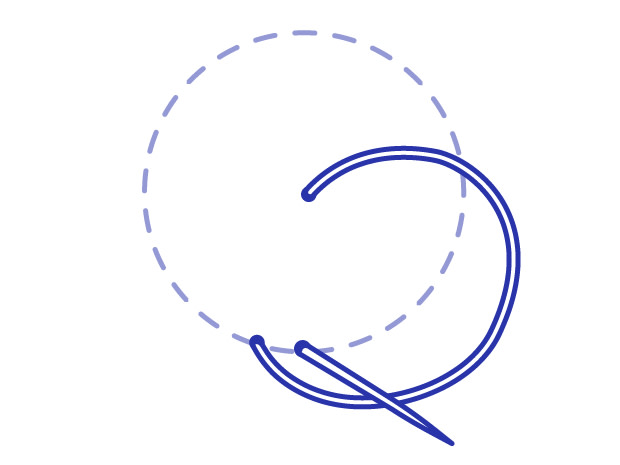Ce guide fournit des diagrammes étape par étape pour les points de broderie les plus courants et explique leur utilisation. Il a été conçu pour accompagner nos tutoriels vidéo qui peuvent être consultés ici. Utilisez les liens ci-dessous pour passer à des points spécifiques ou les faire défiler tous pour trouver l'inspiration.
Utilisez ces liens pour accéder aux étapes et aux diagrammes des principaux points.
Point arrière
Un point plat essentiel qui donne une ligne continue et solide. Très utile pour créer des contours.

Remontez l'aiguille au moment où vous voulez que votre ligne de point arrière commence. Décidez de la longueur de vos points et faites descendre l'aiguille à travers la toile pour faire le premier point.
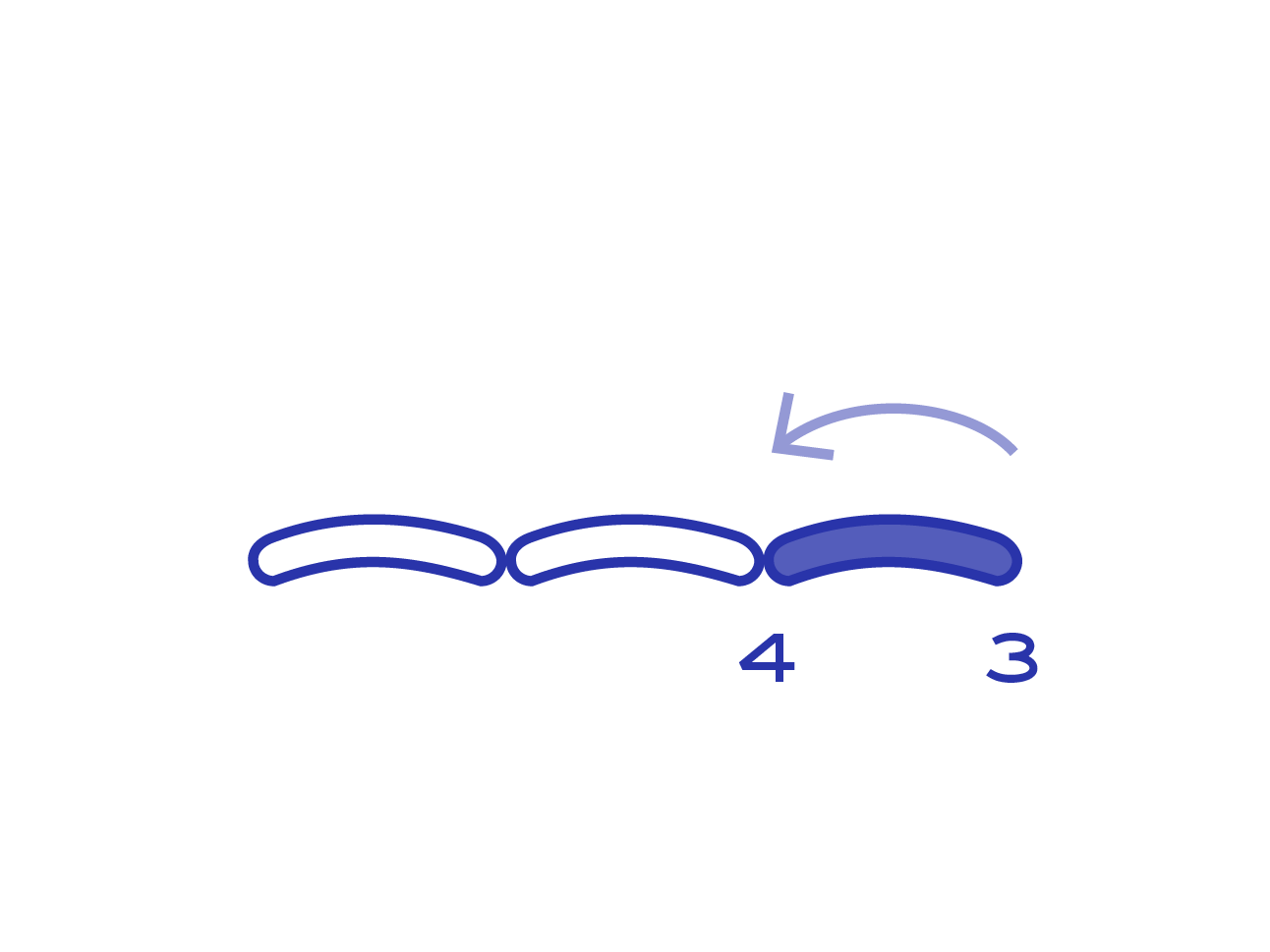
Laissez un espace de la même longueur que votre maille et ramenez l'aiguille vers le haut. En revenant vers votre première maille, faites la deuxième maille en ramenant l'aiguille vers le bas à l'extrémité de la première maille.
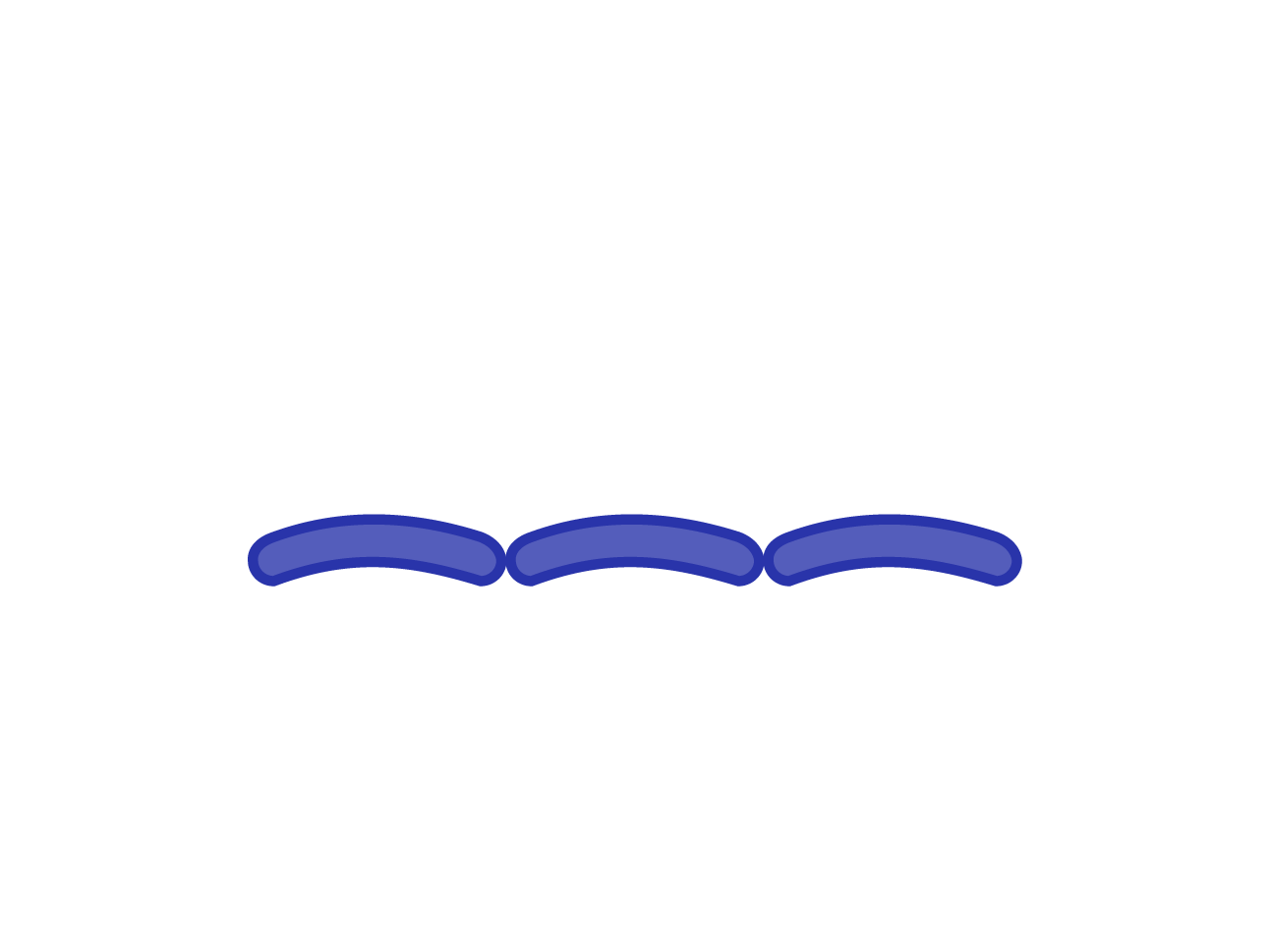
Continuez à faire des points de longueur égale en remontant d'une longueur de point et en fermant le point où votre point précédent s'est terminé.

Remontez l'aiguille au moment où vous voulez que votre ligne de point arrière commence. Décidez de la longueur de vos points et faites descendre l'aiguille à travers la toile pour faire le premier point.

Laissez un espace de la même longueur que votre maille et ramenez l'aiguille vers le haut. En revenant vers votre première maille, faites la deuxième maille en ramenant l'aiguille vers le bas à l'extrémité de la première maille.

Continuez à faire des points de longueur égale en remontant d'une longueur de point et en fermant le point où votre point précédent s'est terminé.
Point arrière (remplissage)
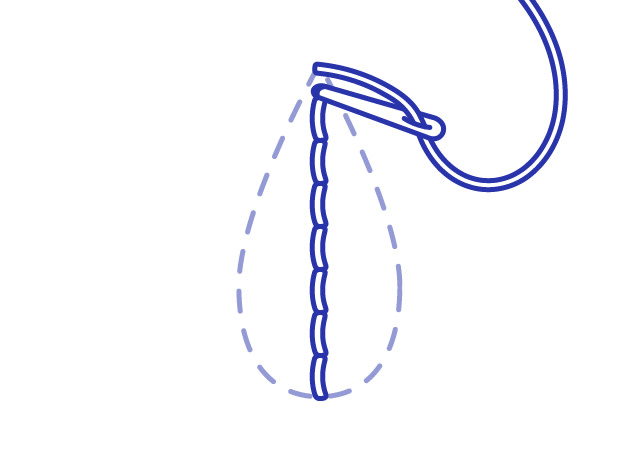
Commencez par piquer une ligne de points arrière au centre de votre forme. Cela permet de définir la longueur et l'angle des points.
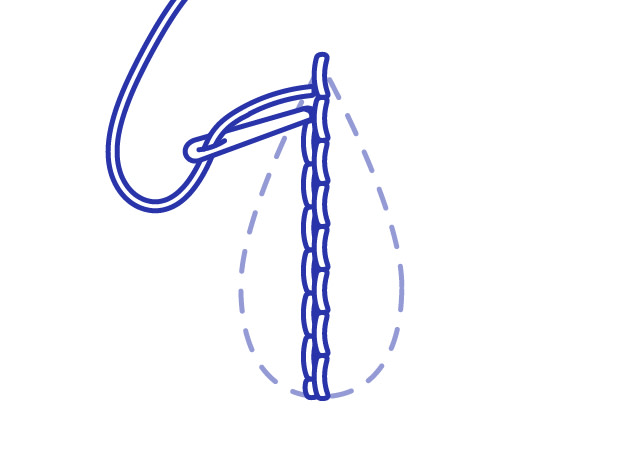
Piquez la rangée suivante de points arrière à côté de la première rangée de manière à ce que le centre de chaque point soit aligné sur l'extrémité de chaque point de la première rangée.

Continuez à remplir la forme avec des points arrière en travaillant du centre vers les bords jusqu'à ce que la forme soit remplie.

Commencez par piquer une ligne de points arrière au centre de votre forme. Cela permet de définir la longueur et l'angle des points.

Piquez la rangée suivante de points arrière à côté de la première rangée de manière à ce que le centre de chaque point soit aligné sur l'extrémité de chaque point de la première rangée.

Continuez à remplir la forme avec des points arrière en travaillant du centre vers les bords jusqu'à ce que la forme soit remplie.
Point de poste
Le point de poste ou les nœuds de poste sont une belle façon d'ajouter de la texture. Utilisez-les pour créer les étamines des fleurs ou piquez des groupes plus importants pour créer une fourrure d'animal. On pense que l'origine de ce point remonte au 10e siècle.

Amenez votre aiguille et votre fil à la surface de votre toile et décidez de la longueur de votre point de poste puis descendez l'aiguille.
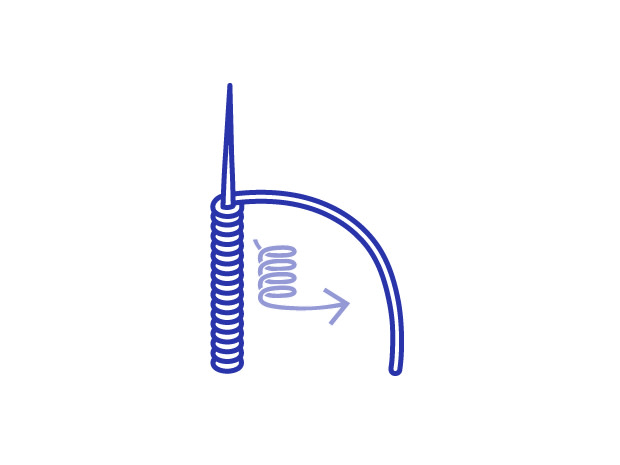
Laissez une boucle de votre fil sur la surface et faites passer votre aiguille par le même trou que celui par lequel vous avez commencé le point. Enroulez soigneusement le fil autour de l'aiguille le nombre de fois nécessaire pour créer un point de poste de la même longueur que l'espace de point que vous avez laissé à l'étape 1 (vous pouvez vérifier en posant l'aiguille sur le tissu et ajuster le nombre de tours pour l'adapter).

Saisissez le fil enroulé tout en tirant l'excédent de fil, puis tirez doucement l'aiguille à travers les enroulements. Tirez sur le fil de travail dans le sens où vous avez fait le noeud pour faciliter la mise en place du noeud, puis faites passer l'aiguille dans le deuxième trou.

Amenez votre aiguille et votre fil à la surface de votre toile et décidez de la longueur de votre point de poste puis descendez l'aiguille.

Laissez une boucle de votre fil sur la surface et faites passer votre aiguille par le même trou que celui par lequel vous avez commencé le point. Enroulez soigneusement le fil autour de l'aiguille le nombre de fois nécessaire pour créer un point de poste de la même longueur que l'espace de point que vous avez laissé à l'étape 1 (vous pouvez vérifier en posant l'aiguille sur le tissu et ajuster le nombre de tours pour l'adapter).

Saisissez le fil enroulé tout en tirant l'excédent de fil, puis tirez doucement l'aiguille à travers les enroulements. Tirez sur le fil de travail dans le sens où vous avez fait le noeud pour faciliter la mise en place du noeud, puis faites passer l'aiguille dans le deuxième trou.
Point de feston
Utilisé à l'origine pour renforcer les boutonnières des vêtements, ce point peut être utilisé aussi bien de manière décorative que fonctionnelle. La seule différence entre la boutonnière et le point de feston est l'espacement entre les points. Il peut être travaillé le long d'un bord droit ou en cercle ou en spirale. Dans cet exemple, nous avons illustré le point de boutonnière où les points sont serrés les uns contre les autres. Mais si vous voulez faire un point de feston, suivez les mêmes étapes, mais espacez les points de façon régulière, avec quelques millimètres entre chacun.

Amenez votre aiguille sur l'extérieur de la forme ou de la ligne que vous voulez piquer, puis sur l'intérieur.

Pour travailler de gauche à droite, tenez une boucle de fil sur la surface de droite et ramenez votre aiguille sur le bord extérieur de votre forme, en vous assurant que l'aiguille est à l'intérieur de la boucle de fil.

Ramenez tout le fil à la surface et faites redescendre l'aiguille aussi près que possible de la droite du point précédent (sur le bord intérieur de la forme). Encore une fois, laissez la boucle et assurez-vous de ramener l'aiguille à l'intérieur de la boucle de fil sur la surface.
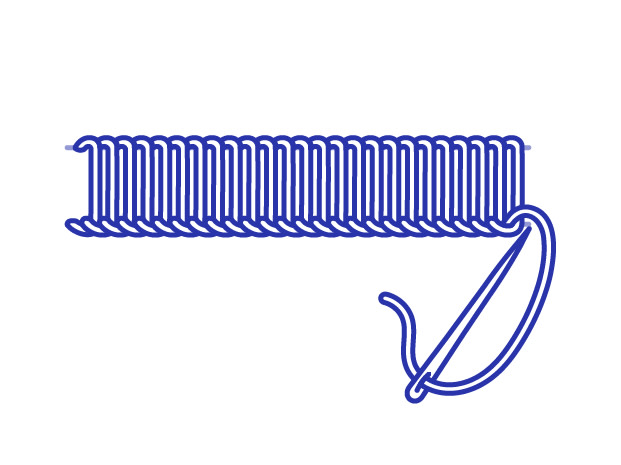
Continuez jusqu'à ce que vous ayez rempli votre forme. Terminez en faisant un petit point de maintien sur le bord extérieur de la dernière boucle.

Amenez votre aiguille sur l'extérieur de la forme ou de la ligne que vous voulez piquer, puis sur l'intérieur.

Pour travailler de gauche à droite, tenez une boucle de fil sur la surface de droite et ramenez votre aiguille sur le bord extérieur de votre forme, en vous assurant que l'aiguille est à l'intérieur de la boucle de fil.

Ramenez tout le fil à la surface et faites redescendre l'aiguille aussi près que possible de la droite du point précédent (sur le bord intérieur de la forme). Encore une fois, laissez la boucle et assurez-vous de ramener l'aiguille à l'intérieur de la boucle de fil sur la surface.

Continuez jusqu'à ce que vous ayez rempli votre forme. Terminez en faisant un petit point de maintien sur le bord extérieur de la dernière boucle.
Point de chaînette
Un point décoratif qui peut être utilisé pour les contours et les bordures ainsi que pour remplir les formes. Il consiste en des boucles de fil qui s'entrecroisent et se maintiennent en place.

Amenez votre aiguille vers le haut, puis redescendez immédiatement à travers le même trou en laissant une petite boucle de fil.
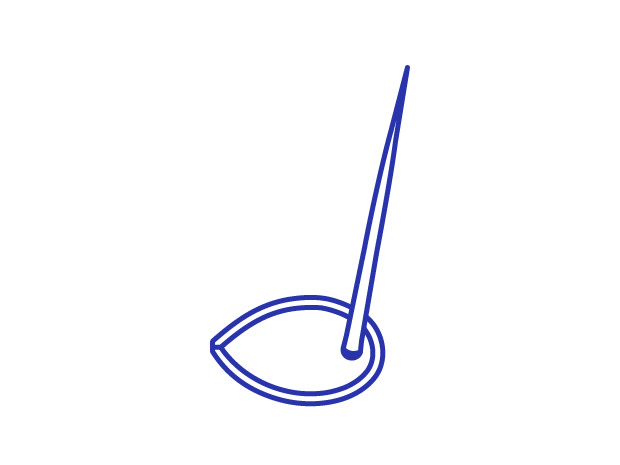
Remontez l'aiguille à mi-chemin de la longueur de point souhaitée en vous assurant qu'elle se trouve à l'intérieur de la boucle de fil que vous avez laissée. Serrez la boucle de fil contre l'aiguille.

Remontez l'aiguille jusqu'en haut pour commencer le point suivant. Répétez l'opération jusqu'à ce que vous ayez terminé votre ligne de points de chaînette. Fixez votre dernière chaîne avec une maille de maintien.

Amenez votre aiguille vers le haut, puis redescendez immédiatement à travers le même trou en laissant une petite boucle de fil.

Remontez l'aiguille à mi-chemin de la longueur de point souhaitée en vous assurant qu'elle se trouve à l'intérieur de la boucle de fil que vous avez laissée. Serrez la boucle de fil contre l'aiguille.

Remontez l'aiguille jusqu'en haut pour commencer le point suivant. Répétez l'opération jusqu'à ce que vous ayez terminé votre ligne de points de chaînette. Fixez votre dernière chaîne avec une maille de maintien.
Point de chevron
Le point de chevron, également connu sous le nom de double chevron, peut être utilisé pour fixer un ruban ou une tresse ou comme un point décoratif à part entière. C'est un excellent choix pour les bordures.
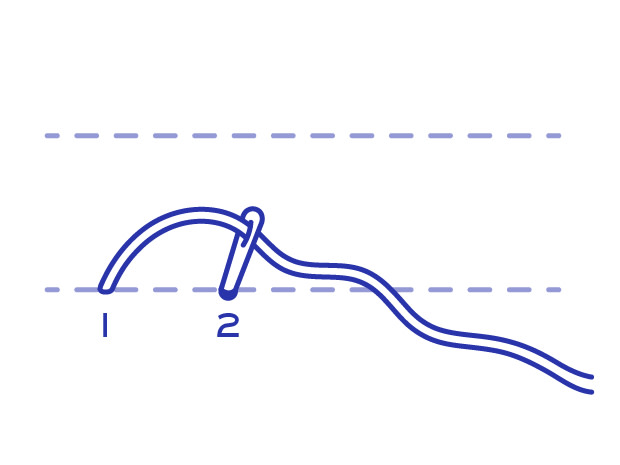
Tracez deux lignes parallèles à l'aide d'un stylo soluble à l'eau. En travaillant de gauche à droite, faites un point droit en amenant l'aiguille en haut à 1 et en bas à 2.

Montez l'aiguille au milieu de la première maille, 3 et descendez à 4. Puis faites un point arrière, en montant à 5 et en descendant à 6.
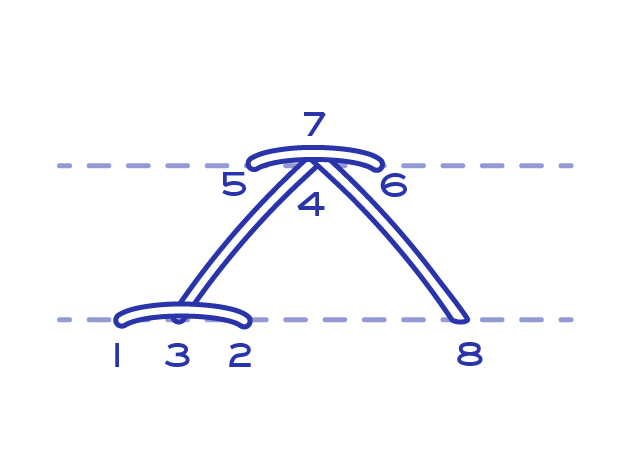
Ramenez la pointe de votre aiguille à travers la toile à mi-chemin entre 5 et 6, au point 7. Faites redescendre votre aiguille au point 8. Répétez l'opération jusqu'à ce que vous ayez créé le nombre de points de chevron souhaité.

Tracez deux lignes parallèles à l'aide d'un stylo soluble à l'eau. En travaillant de gauche à droite, faites un point droit en amenant l'aiguille en haut à 1 et en bas à 2.

Montez l'aiguille au milieu de la première maille, 3 et descendez à 4. Puis faites un point arrière, en montant à 5 et en descendant à 6.

Ramenez la pointe de votre aiguille à travers la toile à mi-chemin entre 5 et 6, au point 7. Faites redescendre votre aiguille au point 8. Répétez l'opération jusqu'à ce que vous ayez créé le nombre de points de chevron souhaité.
Point de remplissage
Un point de remplissage ouvert qui donne un bel effet de treillis. Le point de remplissage utilise de petits points d'ancrage verticaux entre lesquels est tissé un fil.

Espacez régulièrement les points d'ancrage verticaux courts dans des rangées décalées, de sorte que les points de chaque rangée soient à mi-chemin entre les points de la rangée précédente.

Faites remonter le fil de façon à ce qu'il apparaisse sous le point d'ancrage supérieur gauche. Tissez un fil de gauche à droite pour créer un zig zag le long des deux rangées supérieures de points d'ancrage verticaux.

Faites ensuite remonter votre fil sous et à gauche de la dernière maille d'ancrage du troisième rang. Tissez de droite à gauche en créant un zig zag entre la troisième et la deuxième rangée de points d'ancrage. Continuez à tisser selon ce motif jusqu'à ce que toutes les mailles d'ancrage aient été tissées.

Espacez régulièrement les points d'ancrage verticaux courts dans des rangées décalées, de sorte que les points de chaque rangée soient à mi-chemin entre les points de la rangée précédente.

Faites remonter le fil de façon à ce qu'il apparaisse sous le point d'ancrage supérieur gauche. Tissez un fil de gauche à droite pour créer un zig zag le long des deux rangées supérieures de points d'ancrage verticaux.

Faites ensuite remonter votre fil sous et à gauche de la dernière maille d'ancrage du troisième rang. Tissez de droite à gauche en créant un zig zag entre la troisième et la deuxième rangée de points d'ancrage. Continuez à tisser selon ce motif jusqu'à ce que toutes les mailles d'ancrage aient été tissées.
Point colonial
Les point coloniaux sont plus grands et plus ronds que les points de noeud et font partie de la tradition de broderie candlewick du 18e siècle aux États-Unis.

Amenez votre aiguille à l'endroit où vous voulez placer votre point colonial.

Enroulez le fil vers le haut, par-dessus et derrière l'aiguille en formant une figure en 8 autour de l'aiguille, près de la surface de la toile.

Redescendez à travers le tissu tout près du trou que vous avez fait, mais pas dans le même trou. En prenant soin de garder le fil tendu jusqu'à ce que le point soit complètement terminé, tirez le fil jusqu'au bout.

Amenez votre aiguille à l'endroit où vous voulez placer votre point colonial.

Enroulez le fil vers le haut, par-dessus et derrière l'aiguille en formant une figure en 8 autour de l'aiguille, près de la surface de la toile.

Redescendez à travers le tissu tout près du trou que vous avez fait, mais pas dans le même trou. En prenant soin de garder le fil tendu jusqu'à ce que le point soit complètement terminé, tirez le fil jusqu'au bout.
Point de corail
Un joli point de noué qui convient parfaitement aux contours, aux tiges de fleurs et à l'ajout de texture.

Amenez votre aiguille à une extrémité de la ligne du point de corail que vous voulez créer. Posez le fil sur la surface de la toile en suivant la ligne de votre motif.

En maintenant le fil posé, descendez l'aiguille sur un côté de celui-ci à quelques mm de l'endroit où vous avez commencé. Ce premier point fixera la distance entre les nœuds.

Commencez à tirer le fil en laissant une boucle sur la surface, puis faites remonter votre aiguille de l'autre côté du fil posé et à travers la boucle que vous avez laissée. Maintenez l'aiguille dans le tissu et tirez la boucle contre l'aiguille.

Ramenez votre aiguille jusqu'à la surface du tissu et répétez les étapes. Espacez vos nœuds de façon régulière en travaillant le long des lignes de votre motif.

Amenez votre aiguille à une extrémité de la ligne du point de corail que vous voulez créer. Posez le fil sur la surface de la toile en suivant la ligne de votre motif.

En maintenant le fil posé, descendez l'aiguille sur un côté de celui-ci à quelques mm de l'endroit où vous avez commencé. Ce premier point fixera la distance entre les nœuds.

Commencez à tirer le fil en laissant une boucle sur la surface, puis faites remonter votre aiguille de l'autre côté du fil posé et à travers la boucle que vous avez laissée. Maintenez l'aiguille dans le tissu et tirez la boucle contre l'aiguille.

Ramenez votre aiguille jusqu'à la surface du tissu et répétez les étapes. Espacez vos nœuds de façon régulière en travaillant le long des lignes de votre motif.
Point de Boulogne
Populaire en orfèvrerie, le point de Boulogne est une méthode utilisée pour fixer le fil à la surface de la toile. Elle est très utile si un fil est trop épais ou trop délicat pour le tissu sur lequel vous brodez. Le point de boulogne est une technique ancienne que l'on retrouve dans des objets de l'Égypte ancienne et dans des tribus nomades du premier millénaire. Le point de boulogne utilise un fil de surface qui est posé sur le dessus du tissu et un fil de couchage qui est utilisé pour piquer par-dessus le fil de surface et le fixer au tissu.

Travaillez de droite à gauche. Amenez le fil de surface sur la toile et positionnez-le en suivant le motif. Avec l'aiguille, là où vous avez enfilé le deuxième fil, sortez sur la surface de la toile à côté du premier fil.

Faites passer l'aiguille de haut en bas dans la toile de l'autre côté du fil de surface, en formant un petit point droit qui fixera le fil de surface.

Continuez à faire de petits points à intervalles réguliers sur toute la longueur du fil de surface. Pour finir, retournez les deux fils et attachez-les.

Travaillez de droite à gauche. Amenez le fil de surface sur la toile et positionnez-le en suivant le motif. Avec l'aiguille, là où vous avez enfilé le deuxième fil, sortez sur la surface de la toile à côté du premier fil.

Faites passer l'aiguille de haut en bas dans la toile de l'autre côté du fil de surface, en formant un petit point droit qui fixera le fil de surface.

Continuez à faire de petits points à intervalles réguliers sur toute la longueur du fil de surface. Pour finir, retournez les deux fils et attachez-les.
Point d'épine en chainette
Ce point est créé en travaillant des points d'arête dans un motif décalé. Il est souvent utilisé pour le smocking et peut être utilisé de manière fonctionnelle pour froncer le tissu ou comme point purement décoratif. À ne pas confondre avec le point long et le point court, il est aussi parfois appelé point de plume.

Faites un point droit mais ne tirez pas le fil jusqu'au bout, laissez plutôt une petite boucle sur la surface. Remontez l'aiguille à mi-chemin, entre le début et la fin de ce premier point mais un peu en dessous, en veillant à ce que votre aiguille soit à l'intérieur de la boucle. Serrez la boucle contre votre aiguille.

Tirez sur l'aiguille et le fil jusqu'au bout, puis enfoncez l'aiguille dans le tissu, de nouveau sur le côté, comme indiqué.

Tirez le fil à travers mais pas complètement, pour créer une autre boucle et amenez l'aiguille en dessous et à mi-chemin entre les trous.
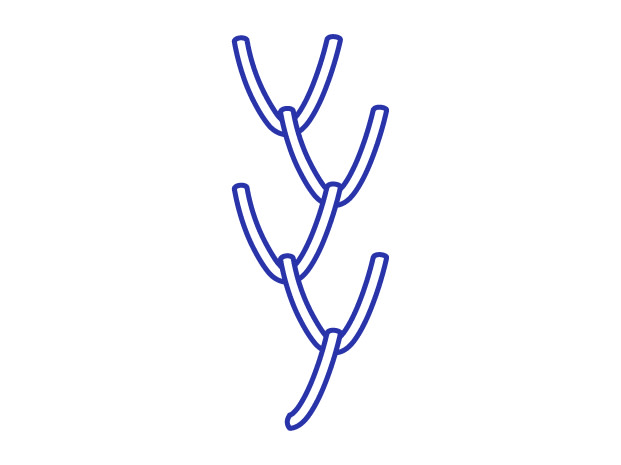
Positionnez votre prochain point d'arête en dessous et légèrement sur le côté de votre dernier point. Continuez à décaler les points pour créer le motif distinctif du point de plume.

Faites un point droit mais ne tirez pas le fil jusqu'au bout, laissez plutôt une petite boucle sur la surface. Remontez l'aiguille à mi-chemin, entre le début et la fin de ce premier point mais un peu en dessous, en veillant à ce que votre aiguille soit à l'intérieur de la boucle. Serrez la boucle contre votre aiguille.

Tirez sur l'aiguille et le fil jusqu'au bout, puis enfoncez l'aiguille dans le tissu, de nouveau sur le côté, comme indiqué.

Tirez le fil à travers mais pas complètement, pour créer une autre boucle et amenez l'aiguille en dessous et à mi-chemin entre les trous.

Positionnez votre prochain point d'arête en dessous et légèrement sur le côté de votre dernier point. Continuez à décaler les points pour créer le motif distinctif du point de plume.
Point de fougère
Le point de fougère utilise trois points droits disposés en éventail pour former une fougère. C'est un joli point décoratif, idéal pour les feuilles et les branches.

Commencez par faire un point vertical, qui déterminera la longueur de tous les autres points.

Faites maintenant un deuxième point en biais sur un côté en faisant descendre votre aiguille dans le même trou que celui qui a été créé par le bas du premier point.

Faites un troisième point de l'autre côté en vous penchant au même angle et en partageant le même trou en bas. Les points de fougère sont parfaits empilés les uns sur les autres.

Commencez par faire un point vertical, qui déterminera la longueur de tous les autres points.

Faites maintenant un deuxième point en biais sur un côté en faisant descendre votre aiguille dans le même trou que celui qui a été créé par le bas du premier point.

Faites un troisième point de l'autre côté en vous penchant au même angle et en partageant le même trou en bas. Les points de fougère sont parfaits empilés les uns sur les autres.
Point de feuille
Un point de remplissage qui utilise des points superposés et fortement inclinés. Un choix idéal pour les feuilles, les pétales et les formes de plumes.

Amenez l'aiguille en haut au centre de la forme que vous remplissez et faites un point vertical.

Remontez à l'extérieur de la forme près du haut du point vertical que vous avez fait et faites un point oblique qui chevauche l'extrémité du point vertical.

En travaillant vers le bas de la forme et en plaçant vos points de façon à ce qu'ils se touchent, continuez à faire des points obliques qui chevauchent la ligne centrale.

Amenez l'aiguille en haut au centre de la forme que vous remplissez et faites un point vertical.

Remontez à l'extérieur de la forme près du haut du point vertical que vous avez fait et faites un point oblique qui chevauche l'extrémité du point vertical.

En travaillant vers le bas de la forme et en plaçant vos points de façon à ce qu'ils se touchent, continuez à faire des points obliques qui chevauchent la ligne centrale.
Point de mouche
Le point de mouche utilise un petit point d'ancrage pour tirer un point droit plus long en forme de V. Il peut être réalisé individuellement ou en ligne pour former des points fermés. Ils peuvent être cousus individuellement ou en rang pour former des points de mouche fermés.
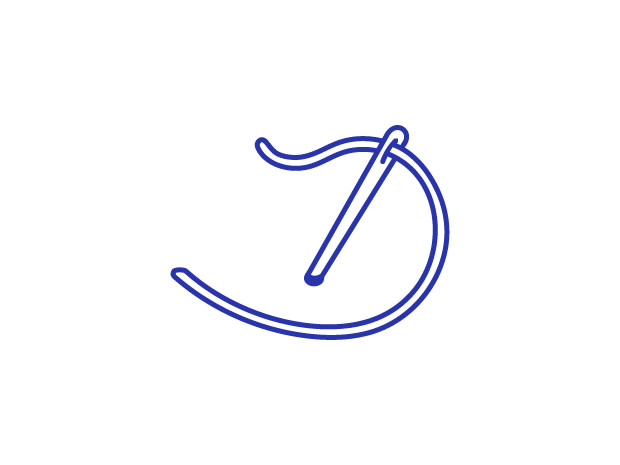
Faites un point droit mais ne tirez pas le fil jusqu'au bout, laissez plutôt une petite boucle sur la surface.

Remontez l'aiguille à mi-chemin, entre le début et la fin de cette première maille, mais un peu en dessous, en vous assurant que votre aiguille est à l'intérieur de la boucle. Serrez la boucle contre votre aiguille.

Tirez l'aiguille et le fil jusqu'au bout, puis enfoncez l'aiguille dans le tissu de nouveau de l'autre côté de la boucle pour la fixer avec un petit point.

Faites un point droit mais ne tirez pas le fil jusqu'au bout, laissez plutôt une petite boucle sur la surface.

Remontez l'aiguille à mi-chemin, entre le début et la fin de cette première maille, mais un peu en dessous, en vous assurant que votre aiguille est à l'intérieur de la boucle. Serrez la boucle contre votre aiguille.

Tirez l'aiguille et le fil jusqu'au bout, puis enfoncez l'aiguille dans le tissu de nouveau de l'autre côté de la boucle pour la fixer avec un petit point.
Point de noeud
Ces petits nœuds sont parfaits pour ajouter de la décoration et créer de la texture. Essayez de les éparpiller ou de les serrer les uns contre les autres pour obtenir des effets différents.

Amenez votre aiguille à l'endroit où vous voulez que votre noeud soit placé.

Enroulez le fil autour de l'aiguille, près de la surface du tissu, une ou deux fois (selon la taille du nœud que vous souhaitez réaliser).

Redescendez à travers le tissu tout près du trou que vous avez fait en remontant, mais pas dans le même trou. En prenant soin de garder le fil tendu jusqu'à ce que le point soit complètement terminé, tirez le fil jusqu'au bout.

Amenez votre aiguille à l'endroit où vous voulez que votre noeud soit placé.

Enroulez le fil autour de l'aiguille, près de la surface du tissu, une ou deux fois (selon la taille du nœud que vous souhaitez réaliser).

Redescendez à travers le tissu tout près du trou que vous avez fait en remontant, mais pas dans le même trou. En prenant soin de garder le fil tendu jusqu'à ce que le point soit complètement terminé, tirez le fil jusqu'au bout.
Demi-point de croix
Le demi-point de croix se travaille en rangs verticaux ou horizontaux. Il crée de courts points perpendiculaires sur l'envers de l'ouvrage, ce qui signifie qu'il utilise moins de fil. Il est idéal pour les projets qui ne doivent pas être particulièrement résistants, comme les tableaux encadrés ou les objets décoratifs.
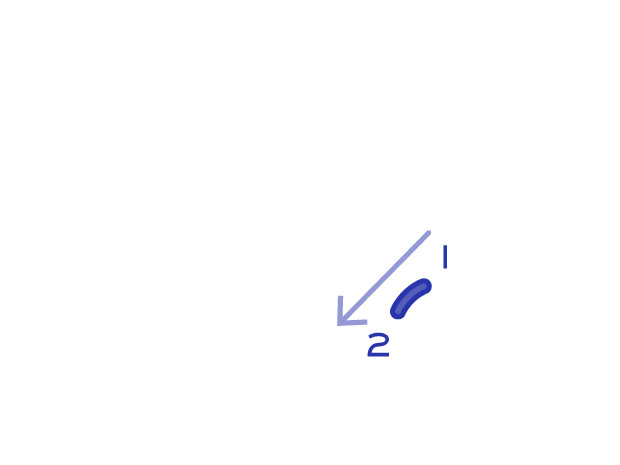
Commencez dans le coin inférieur droit de la section que vous voulez remplir. Faites votre premier point en amenant l'aiguille en haut à droite (1) et en bas à gauche (2).

Faites un point vertical sur le dos de votre toile puis complétez le point scond en l'amenant en bas à gauche (4).

Pour travailler la rangée suivante, l'ordre et la direction sont inversés. Vous travaillerez de gauche à droite en amenant votre aiguille en haut en bas à gauche et en bas en haut à droite comme indiqué.

Commencez dans le coin inférieur droit de la section que vous voulez remplir. Faites votre premier point en amenant l'aiguille en haut à droite (1) et en bas à gauche (2).

Faites un point vertical sur le dos de votre toile puis complétez le point scond en l'amenant en bas à gauche (4).

Pour travailler la rangée suivante, l'ordre et la direction sont inversés. Vous travaillerez de gauche à droite en amenant votre aiguille en haut en bas à gauche et en bas en haut à droite comme indiqué.
Point de chevron
Le point de chevron utilise des rangées de points inclinés qui se croisent aux extrémités pour créer un effet élégant. Populaire dans la broderie jacobine en créole, il est souvent utilisé pour les tiges feuillues.

Tracez deux lignes parallèles à l'aide d'un stylo soluble à l'eau. En travaillant de gauche à droite, réalisez un point droit en amenant l'aiguille vers le haut à l'extrême gauche de la ligne inférieure et vers le bas sur la ligne opposée pour créer un point oblique diagonal, comme illustré .

Faites remonter l'aiguille un peu derrière l'extrémité de cette première maille sur la même ligne. Faites descendre l'aiguille sur la ligne inférieure pour créer un point diagonal qui s'incline dans la direction opposée.

En vous assurant que vos points sont espacés comme indiqué, continuez jusqu'à ce que vous ayez terminé la section à chevrons de votre motif.

Tracez deux lignes parallèles à l'aide d'un stylo soluble à l'eau. En travaillant de gauche à droite, réalisez un point droit en amenant l'aiguille vers le haut à l'extrême gauche de la ligne inférieure et vers le bas sur la ligne opposée pour créer un point oblique diagonal, comme illustré .

Faites remonter l'aiguille un peu derrière l'extrémité de cette première maille sur la même ligne. Faites descendre l'aiguille sur la ligne inférieure pour créer un point diagonal qui s'incline dans la direction opposée.

En vous assurant que vos points sont espacés comme indiqué, continuez jusqu'à ce que vous ayez terminé la section à chevrons de votre motif.
Point arrière entrelacé
Le point arrière entrelacé est une variante du point arrière qui donne un effet ondulé. C'est un choix décoratif pour les contours, les tiges de fleurs ou les lettres.

Commencez par faire un rang au point arrière à l'aide de l'aiguille à broder. Vous pouvez dessiner une ligne pointillée sur votre tissu pour vous aider à faire des points réguliers de la même longueur.

A l'aide d'une aiguille à tapisserie émoussée (pour éviter de percer le point arrière), remontez l'aiguille à la fin de votre rang de point arrière puis glissez-la sous le premier point arrière en gardant le fil à la surface du tissu.

Glissez l'aiguille sous le point arrière suivant en tissant sous les points arrière en zigzag. Abaissez l'aiguille à la fin de la dernière maille arrière.

Commencez par faire un rang au point arrière à l'aide de l'aiguille à broder. Vous pouvez dessiner une ligne pointillée sur votre tissu pour vous aider à faire des points réguliers de la même longueur.

A l'aide d'une aiguille à tapisserie émoussée (pour éviter de percer le point arrière), remontez l'aiguille à la fin de votre rang de point arrière puis glissez-la sous le premier point arrière en gardant le fil à la surface du tissu.

Glissez l'aiguille sous le point arrière suivant en tissant sous les points arrière en zigzag. Abaissez l'aiguille à la fin de la dernière maille arrière.
Point courant lacé
Également connue sous le nom de point courant fouetté, cette variante peut être utilisée pour les bordures et les contours décoratifs. Essayez d'utiliser différentes couleurs de fil pour le point courant et le laçage.
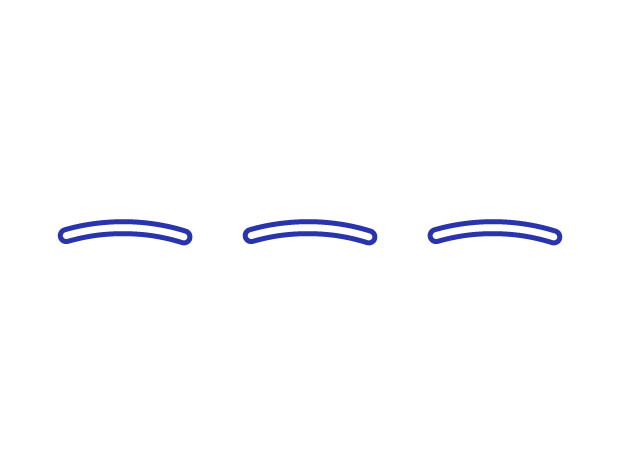
Créez une ligne de points courants en amenant l'aiguille de haut en bas à travers le tissu pour faire des points droits réguliers et régulièrement espacés.

Enfilez sur votre aiguille le fil que vous voulez utiliser pour le laçage. Faites passer l'aiguille par le même trou que celui que vous avez utilisé pour faire votre premier point courant.

Tissez le point de laçage entre le point courant comme indiqué. Terminez la rangée en faisant passer votre fil par le dernier trou de la dernière maille.

Créez une ligne de points courants en amenant l'aiguille de haut en bas à travers le tissu pour faire des points droits réguliers et régulièrement espacés.

Enfilez sur votre aiguille le fil que vous voulez utiliser pour le laçage. Faites passer l'aiguille par le même trou que celui que vous avez utilisé pour faire votre premier point courant.

Tissez le point de laçage entre le point courant comme indiqué. Terminez la rangée en faisant passer votre fil par le dernier trou de la dernière maille.
Point Échelle
Le point d'échelle peut être utilisé pour attacher des appliqués (une pièce de tissu ou un travail d'aiguille qui est appliqué sur le dessus d'un tissu de base) ou pour relier des apparences. Cette variante est également connue sous le nom de point d'échelle invisible ou de point glissé. Il s'agit d'un point ancien, dont l'utilisation est attestée dès le 8e siècle avant Jésus-Christ.

Repliez le bord de votre appliqué. À l'aide d'une aiguille courbe, enfilez et faites un nœud à l'extrémité du fil. Fixez avec deux petits points de maintien dans le tissu de base, à un endroit qui sera caché. Veillez à terminer en faisant remonter l'aiguille dans l'axe du bord replié de l'appliqué.
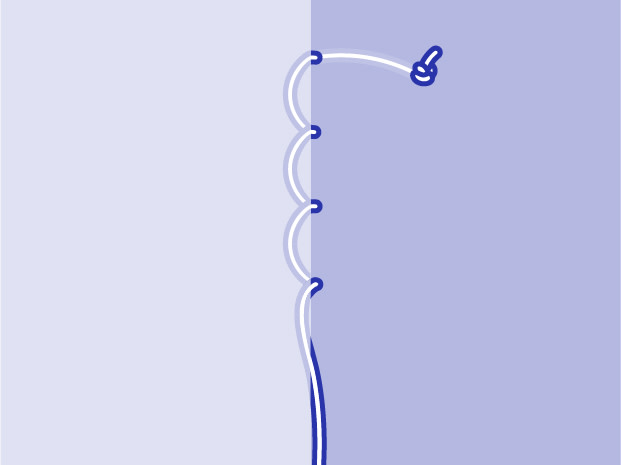
Tirez le fil sur la surface. Posez-le ensuite sur le tissu de base à 90 degrés par rapport au pli et faites un point dans le tissu de base en suivant le bord de votre appliqué. Répétez l'opération sur tout le pourtour de votre appliqué.

Repliez le bord de votre appliqué. À l'aide d'une aiguille courbe, enfilez et faites un nœud à l'extrémité du fil. Fixez avec deux petits points de maintien dans le tissu de base, à un endroit qui sera caché. Veillez à terminer en faisant remonter l'aiguille dans l'axe du bord replié de l'appliqué.

Tirez le fil sur la surface. Posez-le ensuite sur le tissu de base à 90 degrés par rapport au pli et faites un point dans le tissu de base en suivant le bord de votre appliqué. Répétez l'opération sur tout le pourtour de votre appliqué.
Point de marguerite
Également connu sous le nom de point de chaînette détaché ou de point de chaînette simple. Les points de marguerite peuvent être réalisés en cercle pour créer des formes de fleurs simples.

Amenez l'aiguille à l'endroit où vous voulez que la pointe de ce point en forme de pétale soit.

Faites redescendre l'aiguille par le même trou en laissant une petite boucle de fil sur la surface.

Décidez de la longueur du pétale et faites remonter l'aiguille à l'intérieur de la boucle à cette distance. En tenant l'aiguille dans le tissu, serrez doucement la boucle contre votre aiguille.

Amenez l'aiguille à l'endroit où vous voulez que la pointe de ce point en forme de pétale soit.

Faites redescendre l'aiguille par le même trou en laissant une petite boucle de fil sur la surface.

Décidez de la longueur du pétale et faites remonter l'aiguille à l'intérieur de la boucle à cette distance. En tenant l'aiguille dans le tissu, serrez doucement la boucle contre votre aiguille.
Passé plat empiétant
Ce point de remplissage, qui interpose des points longs et courts, est également connu sous le nom de point de satin. Il s'agit d'une série de points droits rapprochés de différentes longueurs utilisés pour remplir une forme.

Préparez-vous en travaillant un contour de point fendu. Pensez à la direction de vos points car cela aura un impact sur l'effet créé par ce point. Vous pouvez dessiner des lignes directrices pour vous aider à orienter vos points dans la bonne direction.
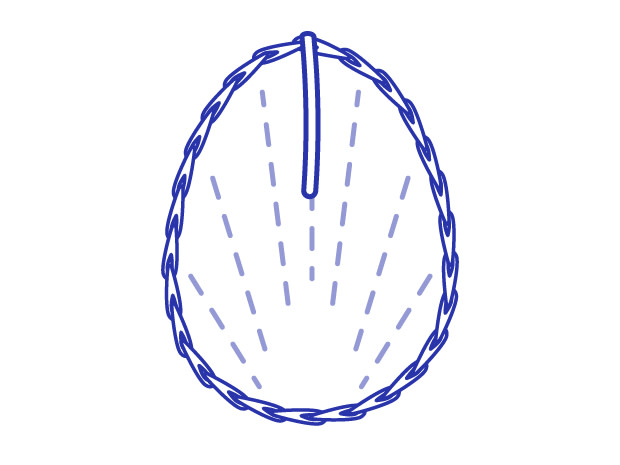
Faites remonter l'aiguille au centre de votre forme et, en suivant vos directives, faites un point droit en faisant descendre l'aiguille à l'extérieur de votre contour de point fendu.

Continuez à faire des points droits de différentes longueurs, en plaçant chacun d'eux le long du point précédent jusqu'à ce que vous ayez rempli la forme.

Préparez-vous en travaillant un contour de point fendu. Pensez à la direction de vos points car cela aura un impact sur l'effet créé par ce point. Vous pouvez dessiner des lignes directrices pour vous aider à orienter vos points dans la bonne direction.

Faites remonter l'aiguille au centre de votre forme et, en suivant vos directives, faites un point droit en faisant descendre l'aiguille à l'extérieur de votre contour de point fendu.

Continuez à faire des points droits de différentes longueurs, en plaçant chacun d'eux le long du point précédent jusqu'à ce que vous ayez rempli la forme.
Point de cordonnet
Le point de cordonnet crée une ligne étroite, lisse et légèrement en relief. Essayez-le pour ajouter un contour plus prononcé ou des détails en relief comme les tiges de fleurs ou les nervures des feuilles.

Créez une ligne de point avant.

Amenez l'aiguille à l'une des extrémités de votre ligne de point avant, très près du point. Faites de petits points par-dessus le point courant pour le recouvrir complètement.

Veillez à ce que chaque point de cordonnet soit posé en touchant le point précédent de façon à ce qu'on ne voie pas le point avant.

Créez une ligne de point avant.

Amenez l'aiguille à l'une des extrémités de votre ligne de point avant, très près du point. Faites de petits points par-dessus le point courant pour le recouvrir complètement.

Veillez à ce que chaque point de cordonnet soit posé en touchant le point précédent de façon à ce qu'on ne voie pas le point avant.
Passé plat rembourré
Cette version rembourrée du passé plat est utilisée pour remplir des formes avec des points parallèles droits et elle met vraiment en valeur le magnifique lustre des fils DMC comme Mouliné Spécial. Le rembourrage ajoute une fabuleuse qualité 3D. Il est idéal pour les baies arrondies et les yeux des animaux.

Créez une bordure nette autour de votre motif avec une ligne de points fendus. Ensuite, piquez des points de remplissage sur l'intérieur de la forme à doubler. Selon l'épaisseur du remplissage que vous souhaitez, vous pouvez faire un point de sable ou un point de coulée d'abord dans un sens puis dans un autre. Travaillez des points plats du centre de la forme vers un bord, puis du centre vers l'autre bord.
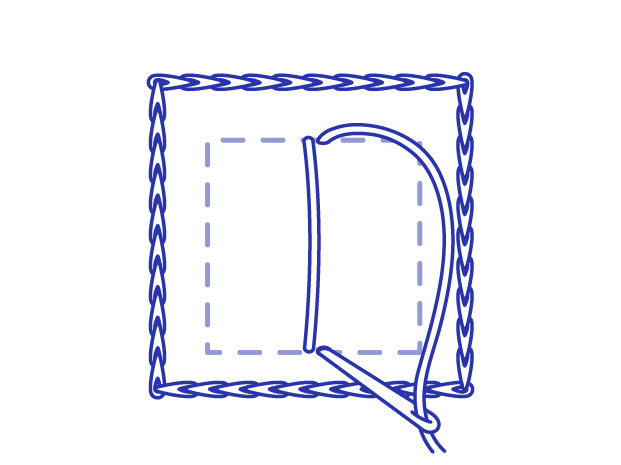
Une fois que vous avez ajouté vos points de rembourrage, vous allez travailler les points plat du milieu de la forme vers un bord, puis du milieu vers l'autre bord. Amenez votre aiguille à l'extérieur du contour du point fendu, à mi-chemin d'un côté de la forme. Maintenez le fil sur la surface de la forme pour définir l'angle des points. Descendez votre aiguille à l'extérieur du contour du point fendu.

Remontez l'aiguille tout près du début du premier point et redescendez, de façon à ce que votre deuxième point soit parfaitement placé à côté du premier. Continuez à faire des points plat, chacun étant accolé au précédent, jusqu'à ce que vous ayez atteint le bord de votre forme. Ensuite, recommencez au milieu de votre forme et, en travaillant vers l'extérieur, remplissez l'autre moitié de la forme.

Créez une bordure nette autour de votre motif avec une ligne de points fendus. Ensuite, piquez des points de remplissage sur l'intérieur de la forme à doubler. Selon l'épaisseur du remplissage que vous souhaitez, vous pouvez faire un point de sable ou un point de coulée d'abord dans un sens puis dans un autre. Travaillez des points plats du centre de la forme vers un bord, puis du centre vers l'autre bord.

Une fois que vous avez ajouté vos points de rembourrage, vous allez travailler les points plat du milieu de la forme vers un bord, puis du milieu vers l'autre bord. Amenez votre aiguille à l'extérieur du contour du point fendu, à mi-chemin d'un côté de la forme. Maintenez le fil sur la surface de la forme pour définir l'angle des points. Descendez votre aiguille à l'extérieur du contour du point fendu.

Remontez l'aiguille tout près du début du premier point et redescendez, de façon à ce que votre deuxième point soit parfaitement placé à côté du premier. Continuez à faire des points plat, chacun étant accolé au précédent, jusqu'à ce que vous ayez atteint le bord de votre forme. Ensuite, recommencez au milieu de votre forme et, en travaillant vers l'extérieur, remplissez l'autre moitié de la forme.
Point avant
Le premier point que beaucoup de gens apprennent, le point avant est une ligne de points qui sont tous de la même longueur. C'est un point très polyvalent qui peut être utilisé pour rassembler du tissu, pour matelasser des couches et ajouter des décorations. C'est un point populaire utilisé dans un large éventail de techniques, notamment le sashiko, le point de croix et le kantha.
Passé plat
Le passé plat est utilisé pour remplir des formes avec des points parallèles droits et il met vraiment en valeur la belle brillance des fils DMC comme Mouliné Spécial. Il est idéal pour les monogrammes, les pétales et les feuilles.

Pour créer un bord net et précis, créez un contour de votre forme au point fendu. Vous travaillerez les passés plats du milieu de la forme vers un bord, puis du milieu vers l'autre bord.
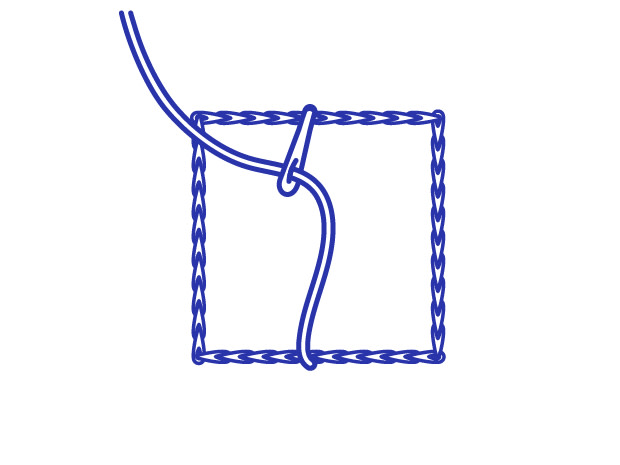
Placez votre aiguille à l'extérieur du contour du point fendu, à mi-chemin d'un côté de la forme. Tenez le fil au-dessus de la surface de la forme pour définir l'angle des points. Descendez votre aiguille à l'extérieur du contour du point fendu.

Remontez l'aiguille tout près du début du premier point et redescendez-la de façon à ce que votre deuxième point repose parfaitement à côté du premier. Continuez à faire des passés plats, chacun étant accolé au précédent, jusqu'à ce que vous ayez atteint le bord de votre forme. Ensuite, recommencez au milieu de votre forme et, en travaillant vers l'extérieur, remplissez l'autre moitié de la forme.

Pour créer un bord net et précis, créez un contour de votre forme au point fendu. Vous travaillerez les passés plats du milieu de la forme vers un bord, puis du milieu vers l'autre bord.

Placez votre aiguille à l'extérieur du contour du point fendu, à mi-chemin d'un côté de la forme. Tenez le fil au-dessus de la surface de la forme pour définir l'angle des points. Descendez votre aiguille à l'extérieur du contour du point fendu.

Remontez l'aiguille tout près du début du premier point et redescendez-la de façon à ce que votre deuxième point repose parfaitement à côté du premier. Continuez à faire des passés plats, chacun étant accolé au précédent, jusqu'à ce que vous ayez atteint le bord de votre forme. Ensuite, recommencez au milieu de votre forme et, en travaillant vers l'extérieur, remplissez l'autre moitié de la forme.
Point de sable
Le point de sable ou point d'ensemencement est un ensemble de petits points droits placés au hasard. Il peut être utilisé pour ajouter de l'ombre en variant la densité des points.
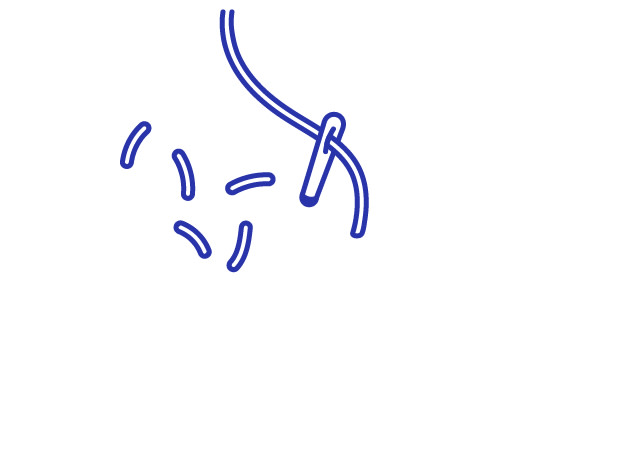
En travaillant dans de nombreuses directions différentes, faites beaucoup de petits points droits de 1-2 mm.

Vous pouvez les tasser étroitement pour une couverture dense.

Écartez-les pour obtenir des effets d'ombrage plus légers.

En travaillant dans de nombreuses directions différentes, faites beaucoup de petits points droits de 1-2 mm.

Vous pouvez les tasser étroitement pour une couverture dense.

Écartez-les pour obtenir des effets d'ombrage plus légers.
Point d'araignée
Le point d'araignée est réalisé en tissant le fil à travers un cercle de points qui sont comme les rayons d'une roue. Il crée un cercle surélevé, idéal pour les fleurs et les taches. Vous créerez ces points de base en descendant votre aiguille au centre du cercle.

Commencez par dessiner un cercle et marquez le centre d'un point. Ensuite, amenez l'aiguille sur le bord du cercle et descendez à travers le point central. Répétez l'opération jusqu'à ce que vous ayez obtenu le nombre souhaité de rayons régulièrement espacés autour du cercle.

Ramenez maintenant votre aiguille entre deux des points que vous avez travaillés, aussi près que possible du centre du point. Tissez ce fil sur et sous les rayons du cercle. Au fur et à mesure que vous travaillez, il se peut que vous deviez pousser doucement le fil en place pour que les tours de tissage soient bien placés.

Continuez à tisser des ronds jusqu'à ce que vous ayez couvert tous les rayons. Relâchez légèrement chaque tour pour qu'ils reposent bien à plat sur le tissu. Pour terminer, enfoncez l'aiguille sous le tour précédent et attachez votre fil à l'arrière de votre ouvrage.

Commencez par dessiner un cercle et marquez le centre d'un point. Ensuite, amenez l'aiguille sur le bord du cercle et descendez à travers le point central. Répétez l'opération jusqu'à ce que vous ayez obtenu le nombre souhaité de rayons régulièrement espacés autour du cercle.

Ramenez maintenant votre aiguille entre deux des points que vous avez travaillés, aussi près que possible du centre du point. Tissez ce fil sur et sous les rayons du cercle. Au fur et à mesure que vous travaillez, il se peut que vous deviez pousser doucement le fil en place pour que les tours de tissage soient bien placés.

Continuez à tisser des ronds jusqu'à ce que vous ayez couvert tous les rayons. Relâchez légèrement chaque tour pour qu'ils reposent bien à plat sur le tissu. Pour terminer, enfoncez l'aiguille sous le tour précédent et attachez votre fil à l'arrière de votre ouvrage.
Point d'araignée festonné
Le point d'araignée festonné commence de la même manière que le point d'araignée, mais au lieu de tisser sous et sur les rayons, vous enroulez le fil autour d'eux. Cela crée un point en relief qui met en valeur les rayons sur lesquels il est formé. Il est également idéal pour les fleurs et les taches. Si vous avez un nombre impair de rayons, vous créerez ces points de base en descendant votre aiguille au centre du cercle (comme décrit ci-dessous). (Comme décrit ci-dessous) Si vous avez un nombre pair de rayons, vous pouvez les créer en piquant en travers du cercle.
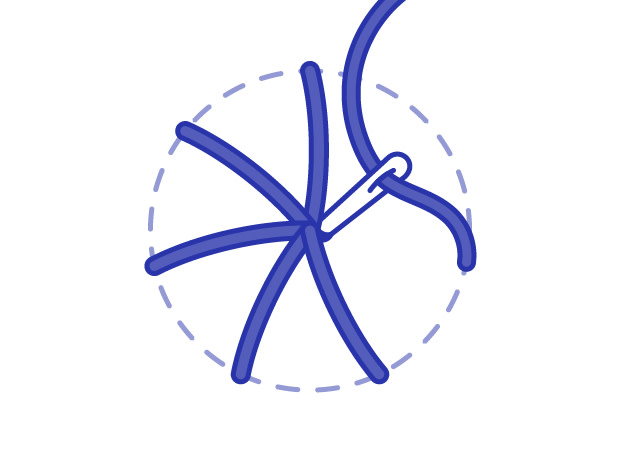
Pour réaliser un point d'araignée surjeté avec un nombre impair de rayons, commencez par dessiner un cercle et marquez le centre d'un point. Ensuite, amenez l'aiguille sur le bord du cercle et descendez à travers le point central. Répétez l'opération jusqu'à ce que vous obteniez le nombre désiré de rayons régulièrement espacés autour du cercle.

Amenez maintenant votre aiguille entre deux des points que vous avez travaillés, aussi près que possible du centre du point. Passez votre aiguille sous le premier rayon et enroulez votre fil tout autour de ce rayon sur la surface du tissu (vous trouverez peut-être plus facile d'utiliser une aiguille à tapisserie à pointe émoussée pour éviter d'accrocher le tissu). Au fur et à mesure que vous travaillez, il se peut que vous deviez pousser doucement le fil en place pour que les tours d'enroulement se placent proprement.
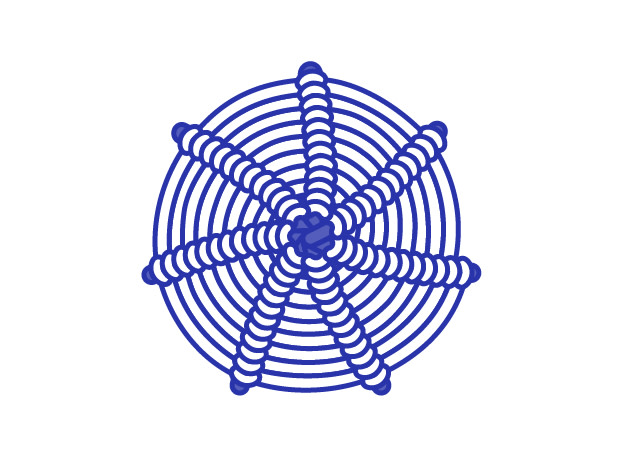
Continuez à enrouler chaque rayon en rond jusqu'à ce que vous ayez couvert tous les rayons. Pour terminer, enfoncez l'aiguille sous le tour précédent et attachez votre fil à l'arrière de votre ouvrage.

Pour réaliser un point d'araignée surjeté avec un nombre impair de rayons, commencez par dessiner un cercle et marquez le centre d'un point. Ensuite, amenez l'aiguille sur le bord du cercle et descendez à travers le point central. Répétez l'opération jusqu'à ce que vous obteniez le nombre désiré de rayons régulièrement espacés autour du cercle.

Amenez maintenant votre aiguille entre deux des points que vous avez travaillés, aussi près que possible du centre du point. Passez votre aiguille sous le premier rayon et enroulez votre fil tout autour de ce rayon sur la surface du tissu (vous trouverez peut-être plus facile d'utiliser une aiguille à tapisserie à pointe émoussée pour éviter d'accrocher le tissu). Au fur et à mesure que vous travaillez, il se peut que vous deviez pousser doucement le fil en place pour que les tours d'enroulement se placent proprement.

Continuez à enrouler chaque rayon en rond jusqu'à ce que vous ayez couvert tous les rayons. Pour terminer, enfoncez l'aiguille sous le tour précédent et attachez votre fil à l'arrière de votre ouvrage.
Point fendu
Le point fendu est utilisé pour les contours et le rembourrage de certains points (par exemple, le passé plat et le point long et court). Il s'agit d'une forme de point arrière qui ressemble un peu à un mini point de chaînette.

Amenez l'aiguille à l'endroit où vous voulez que votre ligne de points fendus commence. Réglez la longueur de point souhaitée en faisant un point droit. Assurez-vous que tous vos autres points correspondent à cette longueur.

Ramenez votre aiguille au milieu de votre première maille. Votre aiguille doit fendre le fil.
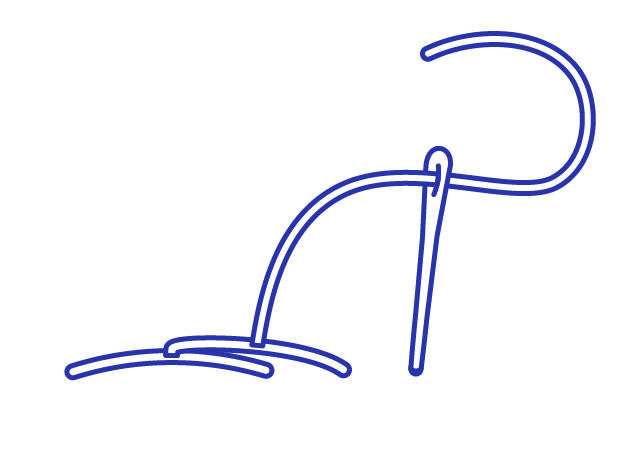
Faites redescendre l'aiguille à travers le tissu, en créant un nouveau point de la même longueur, puis remontez votre aiguille au centre de ce point. Continuez à diviser le point précédent en remontant votre aiguille jusqu'à ce que votre ligne de points fendus soit complète.

Amenez l'aiguille à l'endroit où vous voulez que votre ligne de points fendus commence. Réglez la longueur de point souhaitée en faisant un point droit. Assurez-vous que tous vos autres points correspondent à cette longueur.

Ramenez votre aiguille au milieu de votre première maille. Votre aiguille doit fendre le fil.

Faites redescendre l'aiguille à travers le tissu, en créant un nouveau point de la même longueur, puis remontez votre aiguille au centre de ce point. Continuez à diviser le point précédent en remontant votre aiguille jusqu'à ce que votre ligne de points fendus soit complète.
Point d'étoile
Ce point décoratif consiste en plusieurs points droits sortant d'un petit trou central. Variez la longueur et le nombre de points pour obtenir différents effets.

En commençant par le haut, amenez l'aiguille vers le haut en 1 et vers le bas au centre en 2.

Amenez l'aiguille en haut à 3 et en bas au centre à 2.

Continuez à piquer dans le sens des aiguilles d'une montre jusqu'à ce que vous ayez 8 points placés de manière égale pour créer une étoile.

En commençant par le haut, amenez l'aiguille vers le haut en 1 et vers le bas au centre en 2.

Amenez l'aiguille en haut à 3 et en bas au centre à 2.

Continuez à piquer dans le sens des aiguilles d'une montre jusqu'à ce que vous ayez 8 points placés de manière égale pour créer une étoile.
Point d'étoile (double point de croix)
Ce point d'étoile ou double point de croix, comme on l'appelle également, se compose d'un point de croix diagonal surmonté d'un point de croix droit.

Réalisez d'abord un point de croix diagonal en amenant l'aiguille en haut à 1, en bas à 2, en haut à 3 et en bas à 4.

Effectuez ensuite un point vertical du centre inférieur au centre supérieur.

Complétez l'étoile en faisant une maille horizontale sur toutes les mailles, du centre gauche au centre droit.

Réalisez d'abord un point de croix diagonal en amenant l'aiguille en haut à 1, en bas à 2, en haut à 3 et en bas à 4.

Effectuez ensuite un point vertical du centre inférieur au centre supérieur.

Complétez l'étoile en faisant une maille horizontale sur toutes les mailles, du centre gauche au centre droit.
Point de tige (Inc. Double point de tige)
Le point de tige est un point très populaire pour les lettres et les contours, composé de points droits décalés côte à côte. Pour créer un point de tige double, travaillez deux lignes de point de tige côte à côte.

Réglez votre longueur de point en faisant un seul point droit à l'endroit où vous voulez que votre point de tige commence. Laissez ce point un peu lâche.

Maintenez ce point lâche à l'écart vers la droite et remontez votre aiguille sur la moitié de sa longueur et serrez le point contre lui.

Faites votre point suivant de la même manière, en tenant toujours le point lâche du même côté, en le serrant contre l'aiguille avant de faire le point suivant.

Réglez votre longueur de point en faisant un seul point droit à l'endroit où vous voulez que votre point de tige commence. Laissez ce point un peu lâche.

Maintenez ce point lâche à l'écart vers la droite et remontez votre aiguille sur la moitié de sa longueur et serrez le point contre lui.

Faites votre point suivant de la même manière, en tenant toujours le point lâche du même côté, en le serrant contre l'aiguille avant de faire le point suivant.
Point lancé
Un point lancé est exactement cela. Il peut être réalisé avec n'importe quel fil ou même un ruban et fait partie intégrante de nombreux autres points. Choisissez la longueur, la direction et l'espacement en fonction de l'esthétique et de l'objectif de votre projet.

Faites monter votre aiguille sur la surface du tissu et redescendez un peu plus loin.

Pour vous aider à placer des points lancés avec précision, vous pouvez tenir le fil sur la surface de votre ouvrage à l'endroit où vous voulez qu'il se place et piquer à travers votre fil ou votre ruban.

Faites monter votre aiguille sur la surface du tissu et redescendez un peu plus loin.

Pour vous aider à placer des points lancés avec précision, vous pouvez tenir le fil sur la surface de votre ouvrage à l'endroit où vous voulez qu'il se place et piquer à travers votre fil ou votre ruban.
Point de croix droit
Utilisez ce point de croix vertical pour ajouter une décoration ou comme bordure.

En travaillant de gauche à droite, créez un point horizontal en amenant votre aiguille en haut à 1 et en bas à 2.

Créez un point vertical en amenant votre aiguille en haut à 3 et en bas à 4.

Continuez le point suivant en montant à 5 et en descendant à 6, etc. Continuez ainsi jusqu'à ce que vous ayez créé tous les points de croix verticaux que vous souhaitez.

En travaillant de gauche à droite, créez un point horizontal en amenant votre aiguille en haut à 1 et en bas à 2.

Créez un point vertical en amenant votre aiguille en haut à 3 et en bas à 4.

Continuez le point suivant en montant à 5 et en descendant à 6, etc. Continuez ainsi jusqu'à ce que vous ayez créé tous les points de croix verticaux que vous souhaitez.
Point de cordonnet
Utilisée pour coudre des tissus, à l'endroit ou à l'envers. Les points doivent être espacés d'environ 2 mm à 2,5 mm et ne doivent pas être plus profonds que nécessaire pour créer une couture solide.

Fixez votre fil en faisant quelques points superposés qui emprisonnent la queue du fil.

Remontez l'aiguille au point 1, tirez le fil sur les bords de la toile et remontez au point 2 en veillant à percer les deux pièces de la toile et à les lier ensemble.

Fixez votre fil en faisant quelques points superposés qui emprisonnent la queue du fil.

Remontez l'aiguille au point 1, tirez le fil sur les bords de la toile et remontez au point 2 en veillant à percer les deux pièces de la toile et à les lier ensemble.

